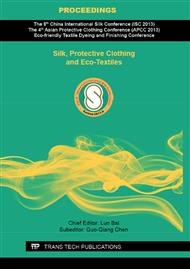[1]
Bodmeier R, Chen HG, Paeratakul O. A novel approach to the oral delivery of micro or nanoparticles. Pharm Res. 6(5), (1989), p.413.
Google Scholar
[2]
Calvo P, Remunan-Lopez C, Vila-Jato JL. Novel hydrophilic chitosan-polyethylene oxide nanoparticles as protein carriers. J Appl Poly Sci. 63(1) , (1997), p.25.
DOI: 10.1002/(sici)1097-4628(19970103)63:1<125::aid-app13>3.0.co;2-4
Google Scholar
[3]
W U Zhenyu, CH EN Zhong, HUANG Hua. The conditions and significance of the preparation of Chitosan nanoparticles by ionotropic gelation. Journal of Nantong university(Medical Sciences). 25(1), (2005), p.20.
Google Scholar
[4]
Tobio M. Gerf R. Sanchez A. et al. Stealth PLA PEG nanoparticls as protein carriers for nasal administration. Pharm Res. 15, (1998), pp.270-275.
Google Scholar
[5]
Janes K A, Calvo P, Alonso M J. Polysaccharide colloidal particles as delivery systems for macromolecules. Advanced Drug Delivery Review. 47(1) , (2001), pp.83-97.
DOI: 10.1016/s0169-409x(00)00123-x
Google Scholar
[6]
YALPANI M, JOHNSON F, ROBINSON L E. Advances in chitin and chitosan[M]. New York: Elsevier Applied Science. (1995), p.543-56l.
Google Scholar
[7]
W.X. Li, Y.M. Shi, Y.H. Zhao. Studies on anti-wrinkle of silk with CA solution. Journal of Dyeing and Finishing. 11, (2001), p.6.
Google Scholar
[8]
S.H. Hsieh, Z.K. Huang, Z.Z. Huang, and Z.S. Tseng. Antimicrobial and physical properties of woolen fabrics cured with citric acid and chitosan. J. Appl. Polym. Sci. 94, , (2004), p. (1999).
DOI: 10.1002/app.21104
Google Scholar
[9]
Yu Jia-hui, Du Yu-min, Zheng Hua. Blend Films of Chitosan/Gelation[J]. J Wuhan Univ(Nat Sci Ed). 45(4) , (1999), pp.440-444.
DOI: 10.1007/bf02832288
Google Scholar
[10]
Chen Xin, Li Wen-jun, Yu Ton-yin. Investigation of Adsorption Properties of Chitosan/Cu(II) Complex in Chitosan-Silk Fibroin Blend Membranes as Adsorbents for Urea[J]. Chinese J Biomed Eng, 16, (1997), pp.284-288.
Google Scholar
[11]
Brow D D, Flord A J, Sainburg M. Organic Spectroscopy[M]. New York: John Wiley inc. (1988), pp.24-50.
Google Scholar
[12]
Xu Yong-mei, Du Yu-min. Studies on Controlled Release of Protein Drugs from Chitosan Nanoparticles with Low Molecular Weight[J]. Wuhan Univ. (Nat. Sci. Ed. ), 49(04) , (2003), pp.470-474.
Google Scholar
[13]
Knaul J Z, Hudson S M, Creber K A M. Improved Mechanical Properties of Chitosan Fibers[J]. J ApplPolym Sci. 72, (1999), pp.1721-1731.
DOI: 10.1002/(sici)1097-4628(19990624)72:13<1721::aid-app8>3.0.co;2-v
Google Scholar
[14]
DING De-run, SHEN Yong. AntibacteriaI finishing with chitosan erivatives and their nanoparticle. Journal of Dyeing and Finishing. 14 , (2005), p.14.
Google Scholar
[15]
Kim J H, Lee Y M. Synthesis and Properties of Diethylamine Ethyl Chitosan[J]. Polymer. 34 (9) , (1993), p.1952-(1957).
Google Scholar
[16]
Pan Y, Li YJ, Zhao HY, et a1. Bioadhesive polysaccharide in protein delivery system: chitosan nanoparticles improve the intestinal absorption of insulin in vivo. Int J Pharm. 249(1-2), (2002), p.139.
DOI: 10.1016/s0378-5173(02)00486-6
Google Scholar
[17]
Salt H, Tabeta R, Ogawa K. High-Resolution solid-State 13C NMR Study of Chitosan and Its Salt with Acids. Conformational Characterization of Polymorphs and Helical Structures as Viewed from the Conformation Dependent 13C Chemical Shifts. Macromolecules. 20(10), (1987).
DOI: 10.1021/ma00176a017
Google Scholar
[18]
Y.H. Lu,H. Lin Y.Y. Chen,C. Wang and Y.R. Hua. Structure and Performance of B. mori Silk Modified with Nano-TiO2 and Chitosan. Fibers and Polymers. 8(1), ( 2007), pp.1-6.
DOI: 10.1007/bf02908152
Google Scholar


